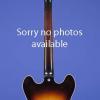A Specially-Ordered "Convertible" with "Sal Salvador" Features
This 17-inch-wide jazz guitar with a Lotus Ivory top and Copper Mist body weighs just 6.40 lbs. and has a nice, fat nut width of slightly over 1 11/16 inches and a scale length of 25 1/2 inches. Spruce top with two large bound f-holes, laminated rock maple back and sides, rock maple neck, and bound ebony fretboard with 21 frets and neo-classic inlaid pearl thumbprint (half-moon) position markers. Headstock with inlaid pearl Gretsch "T-roof" logo. Individual Grover Imperial tuners with stairstep metal buttons. One DeArmond (Gretsch Dynasonic) pickup with an output of 9.51k. Gold-painted elongated Lucite pickguard with Gretsch "T-roof" logo in black (the pickguard covers most of the treble f-hole). Two controls (one volume, one tone) mounted on pickguard. Rosewood bridge with pre-set compensating saddle and separate "G-hole flat" tailpiece. All hardware gold-plated. This guitar is in excellent plus (8.75) condition. There is some finish checking, especially on the top. Housed in the original dark gray Gretsch hardshell case with purple plush lining (9.00).
This 1956 Convertible (with serial number "19501") has two features found on the later Sal Salvador model: an ebony fretboard and neo-classic thumbprint (half-moon) position markers. The regular Convertibles featured a bound rosewood fretboard and hump-top block position markers.
"As a happy medium between the true acoustic archtops like the Eldorados, Fleetwoods and Constellations and the electric Country Clubs...Gretsch showcased its $295 Model 6199 Convertible finished in Bamboo Yellow [Ivory Mist] spruce top and bronze metallic-hued Copper Mist back, sides and neck in 1955. The true f-hole, 17-inch-wide, 3 1/2-inch-deep archtop has a 25 1/2-inch scale that terminates on a compensated, rosewood bridge. The peghead is white-black-white-bound, overlaid in black-stained maple, then inlaid with a real mother-of-pearl "Gretsch" block letter logo. Gold-plated Grover Imperial tuners and a small, bullet-shaped truss rod cover complete the headstock motif. The rosewood fingerboard is inlaid with real pearl humped-block inlays and bound in multiple black and white plastic. A single gold-plated DeArmond pickup is suspended above the top although its large polepieces project through a hole in the spruce, by an attachment to the mammoth, gold-painted, Synchromatic-style, Lucite guardplate which covers almost all of the treble f-hole; tone and volume controls are also located on the 'guard and the control knobs are gold-plated, knurled strap buttons. The suspended DeArmond allows the top to vibrate freely and makes the guitar convertible -- able to be played electrically or acoustically. Convertibles are, infact, good-sounding acoustic archtops. The Model 6199 Convertible's revolutionary two-tone color scheme evokes comparisons to the spilt-level [sic] paint jobs on Plymouth Savoys or Ford Crown Victorias...In 1959 the two-tone Convertible gave way to the sunburst -- the only optional Convertible finish -- Sal Salvador an altogether better guitar although it kept the same model number as the Convertible, with a carved, solid spruce top, solid, curly maple back and sides, a three-piece curly maple-ebony-curly neck, and a raised, extension fingerboard 1 3/4-inches-wide at the nut. The Sal Salvador utilizes a suspended Filter'Tron this year and in 1960, pickguard-mounted controls, a neo-classic ebony fingerboard, 3 1/2-inch body depth and 24K-gold-plated metal parts" (Jay Scott, The Guitars of the Fred Gretsch Company, pp. 175-177).
The first year Model 6199 as it appeared in the 1955 Gretsch catalog: "Play it electric or play it acoustic and get top tone either way. That's because instead of being built-in, the Gretsch-Dynasonic pickup of this guitar is suspended clear of the top to allow full, free vibration. Full, arched 17" body with cutaway; Gretsch slim, fast playing neck. Close-grained choice spruce top; selected rock-maple body and neck. This is a showman's guitar, finished in smart modern style with lotus ivory top and copper mist body and neck. Other features include: Over-size Lucite guard plate mounting the adjustable magnet Gretsch-Dynasonic pickup and the control knobs (volume and tone); Grover 16-to-1 ratio individual, covered machines. Rosewood fingerboard with pearl position markers. Metal parts heavily gold plated" (Jay Scott, The Guitars of the Fred Gretsch Company, p. 176).
Translate:

